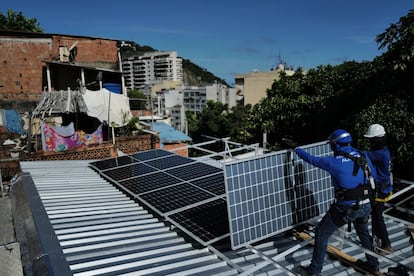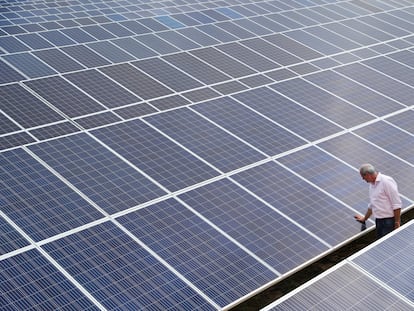Latin America’s huge renewable energy potential: Capacity set to grow 460% by 2030
According to a Global Energy Monitor report, the region may have more than 319 gigawatts of large-scale solar and wind power within the next decade


The arrival of new governments in Latin America and the Caribbean appears to be strengthening the green energy transition in the region. According to a report published Thursday by the Global Energy Monitor, the region is positioned to grow its large-scale solar and wind power capacity by more than 460% by 2030. By that year, the region may have more than 319 gigawatts of solar and wind capacity, based on projects that have been announced, are in pre-construction or under construction. Solar energy alone is set to generate more than 20 megawatts, with wind capacity put at 10 megawatts. The figure does not include energy produced by hydroelectricity.
Currently, solar and wind energy generate 69 GW (27.6 GW and 41.5 GW respectively), which is equivalent to a little more than 15% of the region’s energy capacity. According to the study, the region will be able to reach 319 GW thanks to large-scale projects such as the H2 Magallanes wind farm in Chile and the Berço Das Gerais solar park in Brazil.
The wind farm in Chile is expected to start operating by 2027 and to generate 10 GW of power. “It is being earmarked primarily for green hydrogen production,” the document states. Meanwhile, the Berço Das Gerais solar park in Brazil – which does not have an official start date – is set to be the largest of its kind in Latin America, with capacity to generate 5.7 MW.
Brazil is also set to be home to the largest offshore wind project in the region: the 6.5 GW Ventos Do Sul offshore wind farm, which the operator, Ocean Winds, expects to come online in 2027.
“Brazil used to be like the rest of the countries in Latin America and the Caribbean in that there was no renewable energy,” Kasandra O’Malia, one of the five authors of the report, told EL PAÍS. “But suddenly we are seeing an explosion of projects that are able to generate renewable energy, including in the large territory on the coast.” According to the report, Brazil could have 217 GW of wind and solar capacity by 2030, which would make it the renewable energy leader in the region. Under these projections, it would be followed by Chile (38 GW), Colombia (37 GW), Peru (10 GW) and Mexico (7 GW).
While Mexico is ranked among the top five in terms of prospective wind and solar capacity, the report warns that “Mexico’s utility-scale solar and wind installations have declined.” It adds: “Mexico was a standout leader for utility-scale solar and wind power development for many years with strong annual growth,” but has lost ground due to government policies that have prioritized other energy sources, such as gas.
While the green energy transition is important to mitigating climate change, it has also led to harmful unintended consequences, such as displacement and social conflict, the report warns. In order to avoid this, “every project should begin from community participation and ensure that they benefit the communities where it is taking place, so that they are accepted,” says O’Malia. “Otherwise they will be rejected by locals.”
“Projects are often developed in indigenous territory and are committing the mistakes of extractivism. We are transitioning away from fossil fuels, but we are not applying the justice side of it,” she adds.
The report also highlights this point: “Protests across Latin America since 2020 have focused on resisting new forms of extractivism during the energy transition, with some areas with especially high levels of wind resources, such as La Guajira, Colombia and Oaxaca, Mexico, rocked by social movements demanding deeper local participation in planning processes and more equitable distribution of economic benefits associated with wind developments.”
According to O’Malia: “In an ideal world, the community would be co-owner of the projects.”
Sign up for our weekly newsletter to get more English-language news coverage from EL PAÍS USA Edition
Tu suscripción se está usando en otro dispositivo
¿Quieres añadir otro usuario a tu suscripción?
Si continúas leyendo en este dispositivo, no se podrá leer en el otro.
FlechaTu suscripción se está usando en otro dispositivo y solo puedes acceder a EL PAÍS desde un dispositivo a la vez.
Si quieres compartir tu cuenta, cambia tu suscripción a la modalidad Premium, así podrás añadir otro usuario. Cada uno accederá con su propia cuenta de email, lo que os permitirá personalizar vuestra experiencia en EL PAÍS.
¿Tienes una suscripción de empresa? Accede aquí para contratar más cuentas.
En el caso de no saber quién está usando tu cuenta, te recomendamos cambiar tu contraseña aquí.
Si decides continuar compartiendo tu cuenta, este mensaje se mostrará en tu dispositivo y en el de la otra persona que está usando tu cuenta de forma indefinida, afectando a tu experiencia de lectura. Puedes consultar aquí los términos y condiciones de la suscripción digital.
More information

Latin America could set a global example for a just energy transition
Archived In
Últimas noticias
Most viewed
- Sinaloa Cartel war is taking its toll on Los Chapitos
- Oona Chaplin: ‘I told James Cameron that I was living in a treehouse and starting a permaculture project with a friend’
- Reinhard Genzel, Nobel laureate in physics: ‘One-minute videos will never give you the truth’
- Why the price of coffee has skyrocketed: from Brazilian plantations to specialty coffee houses
- Silver prices are going crazy: This is what’s fueling the rally









































